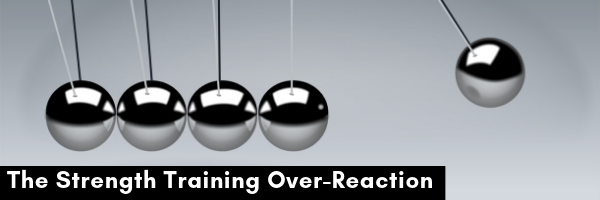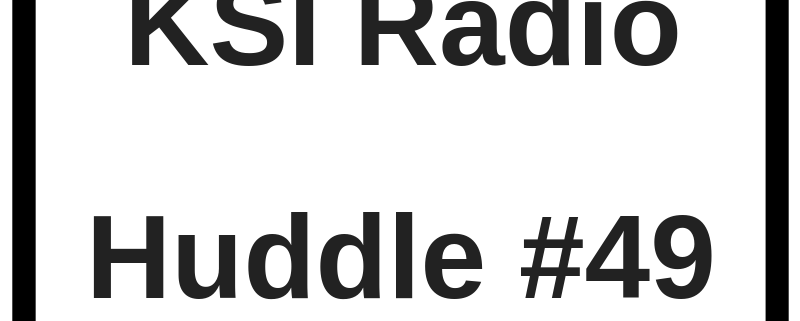The Strength Training Over-Reaction
In the 1950 and 1960s strength training began to appear in US sport. In 1969 Boyd Epley became the first full-time strength coach hired in the US college system. However the dominant belief at that time about strength training was that it made you slower.
As an excellent example of this are the words attributed to Nebraska University Athletic Director Mike Devaney when he hired Boyd Epley:
“If anyone gets slower you’re fired.”
I witnessed first hand this era in Australia, with many sports I worked with during the 1980s at the elite level having no prior involvement in strength training. It wasn’t just athletes and sports coaches that shied away from strength training. Industry professionals had no interest.
In 1988 I was working out in the gym at the Sydney University with the late Charles Poliquin (where the first annual national convention for the National Strength and Conditioning Association of Australasia – as it was known then – was being held) when in bounced through the door two men. One was the person who had essentially brought the organization to Australia and the other was a speaker from South Africa. Both were dressed like Richard Simmons look-a-likes, and they spoke light-heartedly and mockingly about how the ‘aerobs’ (themselves) were off to a jog leaving the ‘anaerobs’ (Poliquin and myself) in the gym. We were apparently two different tribes. You were either a Fixx like jogger (who felt a unique obligation to dress like Richard Simmons!), or a ‘weightlifter’.
I’ll never forget being in the Australian swim team bus in a pre-Olympic training camp for the 1992 Barcelona Olympics.The athlete I was working with and I were receiving significant mocking for our dalliance into serious strength training.
In the 1980s, if you did anymore than bodyweight or dared to leave the Universal multi-lever machine for the free weights, you were targeted by the other athletes and coaches.
It was not until the 1990s that strength training gained acceptance. That’s at least four decades of waiting and hoping for recognition. In the 1990s strength training research boomed, and strength training gained mainstream acceptance. It was no longer the activity of weird men in dark gyms, or the occasional athlete in diverse sports – it was for everyone.
Up until the 1990s a ‘strength coach’ had to prove they were not going to slow down or cause injury to the athlete. Up until about the mid-1990s in Australia I was the only one who had full-time income as a ‘strength coach’, paralleling Poliquin’s experience in Canada. In the mid-1990s things began to shift and positions began to open in the industry in Australia. Post 2000 it became a formality – sporting teams felt obliged to hire strength(and conditioning) coaches.
I share these insights to provide background to my suggestion that what has occurred since is an exuberant over-reaction to a genre that was suppressed for so many decades.
However it’s time to regain balance in the strength perspective.
As a pioneer for strength training in the 1980s and 1990s, I have become an advocate for a more balanced approach since. I am under no illusion – strength training, or the lack of it in sport, was my opening to sport. However unlike some of my colleagues, I didn’t stay there. I moved on to address the success of the athlete in a balanced, holistic fashion, rather than exclusively how much they lifted in the gym.
In the introduction to this series I talked about human over-reaction:
Futurists describe human response to a new idea as an over-reaction in the short term and an under-reaction in the long term.[1]
This is what I suggest has occurred with strength training. Let’s begin with simple examples.
At the 1991 NSCA convention I watched a number of individuals that were obviously athletes but I could not figure out which sport. This was frustrating me as I take the study of athletic shape seriously. They were more muscular than track and field athletes but lacked the upper trap development of the stereotypical weightlifter. And they had larger than average hamstrings.
I was stunned to learn they were in fact weightlifters on the US national team. It was Wednesday June 19 1991 and the pre-convention seminar was titled ‘The US Approach to Teaching the Olympic-style Lifts and their use in Sports’, presented by Dragomir Cioroslan.[2] I learnt a lot that day from Dragomir. One of the lessons was the way he had his athletes perform the stiff legged deadlift. So I called this the ‘Romanian Deadlift’ and wrote about it. It got picked up.
So much so that by the end of the 1990s, and to this day, if you ask someone to do a deadlift they will typically immediately perform a stiff legged deadlift. It virtually caused the conventional bent knee deadlift to become extinct. Or at least in the minds of the masses. This became the norm, the trend.
It didn’t stop there. Prior to late 1990s if you asked someone to do a stiff legged deadlift or good morning (assuming they knew what these exercises were) they would perform them with a rounded back.
Now Dragomir’s stiff legged deadlift was flat backed, and the impact on the hamstring was apparent. So now this became the trend, and no one would perform either the stiff legged deadlift or good morning ever again – or so it seemed. In fact, the next phase was the creation of the trend was that rounded back deadlifting was actually bad.
Did either of these responses need to occur? That a deadlift is a stiff legged deadlift, and that rounded back deadlifting became bad? Not at all. Why did it occur? Because humans over-react.
Now you would imagine that this over-reaction is a short-term ‘thing’. What we don’t know is what a‘short-term’ is defined as? We are nearing the end of our third decade of strength acceptance and the trend of over-reaction is still rising.
So what else influences me to believe we are still over-reacting in favor of strength?
As those who are more familiar with my writing would know I endorse a Tudor Bompa influenced approach to the physical qualities. That there are four dominant physical qualities, presented alphabetically below.
Endurance
Flexibility
Speed
Strength
Most accept that there are other qualities in addition to strength, but I wonder if enough have reflected on their relative values?
One of the greatest examples of this continuing strength bias is the reaction to this statement:
Stretching makes you weak.
The mere forming of these words has effectively discouraged a global generation to stop stretching. For those who want to get stronger, anything that may impede this outcome is unacceptable. An antithesis.
The specifics of the studies, the flaws, the limitations, are ignored. In fact in a ‘study circle’ that I participate in, when latest ‘pre-training static stretching makes you weak’ research article was disseminated not a word was spoken. In contrast, the week before, an article proposing the superiority of isolated chicken protein versus beef protein elicited astute and appropriately probing questions about the study protocol and potential flaws. Analytical thinking was applied. Yet when the words ‘stretching makes you weak’ care across the desk there was silence.
Now imagine this statement, if made today:
Strength training makes you tight.
For those of you who want to get more flexible and supple, this is the antithesis, and you would pause and reflect on your strength training.
But that is not, and would not happen today. Because today strength training is considered to be the most important variable. Note this is a trend – not the way it will always be.
Now rather than it be about strength vs. flexibility (because that is a battle that cannot be one in todays paradigm), how about this:
Strength training negatively impacts skill execution in sport.
Think this is ridiculous? Try this. Assess your basketball free throw line shooting ability. Go and do a pushing upper body workout and IMMEDIATELY return to the free throw line. (Now no one does that in the real world, but minor (?!) details such as that were of no interest in the stretching makes you weak studies!). How’s your shooting going?
Now even though athletes value skill, this is still unlikely to sway strength coaches because of a. their current buy into strength training is the most important training component; and b. their jobs are not being measured by the skill set or even by the scoreboard, but by the 1RM or 3RM of the athlete. And that is just a trend. That will change. One day a more holistic measurement of physical preparation will be applied.
In conclusion, strength as a quality and training method is over-rated in its importance. This is the trend. I suggest you engage in significant reflection before embracing this trend.
[1] King, I., 2000, Foundations of Physical Preparation (DVD)
[2] King, I., 1999, Heavy Metal No. 6, t-mag.com


